💥Enter the Dragon (1973)
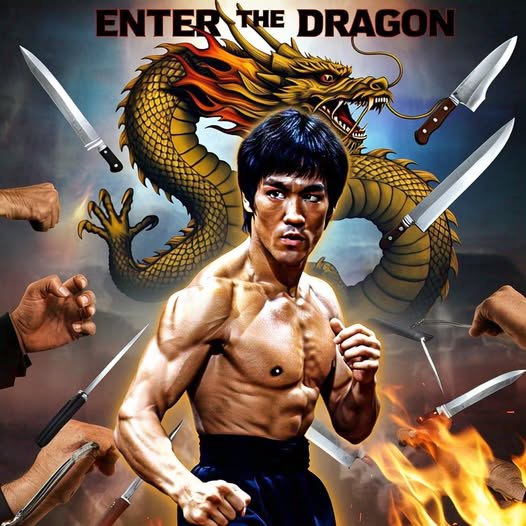
Introducing Enter the Dragon (1973): A Martial Arts Masterpiece
Released on August 17, 1973, Enter the Dragon stands as a landmark in martial arts cinema, a film that not only propelled Bruce Lee to global stardom but also introduced the genre to mainstream Western audiences. Directed by Robert Clouse and produced by Warner Bros. in collaboration with Golden Harvest, this Hong Kong-American action thriller blends electrifying fight choreography, philosophical undertones, and a gritty espionage plot. Starring Bruce Lee as Lee, a Shaolin martial artist recruited to infiltrate a criminal empire, alongside John Saxon and Jim Kelly, Enter the Dragon remains a cultural touchstone over five decades later. This article offers a comprehensive introduction to the film, exploring its origins, plot, cast, production, critical reception, and enduring legacy.

Origins and Development
Enter the Dragon emerged during a pivotal moment for martial arts films. In the early 1970s, Hong Kong cinema, led by studios like Golden Harvest, was gaining international attention through films like The Big Boss (1971) and Fist of Fury (1972), both starring Bruce Lee. Lee, a Chinese-American martial artist and actor, had already become a sensation in Asia, but Hollywood had yet to fully embrace the genre. Warner Bros., recognizing the growing popularity of kung fu films, partnered with Golden Harvest to produce a crossover project that would appeal to both Eastern and Western audiences.
The film’s concept originated from producer Fred Weintraub, who envisioned a martial arts spectacle with a James Bond-inspired plot. Initially titled Han’s Island and later Blood and Steel, the project was renamed Enter the Dragon to evoke mystique and power. Screenwriter Michael Allin crafted a story that combined espionage, tournament combat, and Lee’s Jeet Kune Do philosophy, while director Robert Clouse, known for thrillers like Darker Than Amber (1970), was hired to helm the production. Filming began in Hong Kong in early 1973, with a modest budget of $850,000—a figure that belied the film’s eventual global impact.
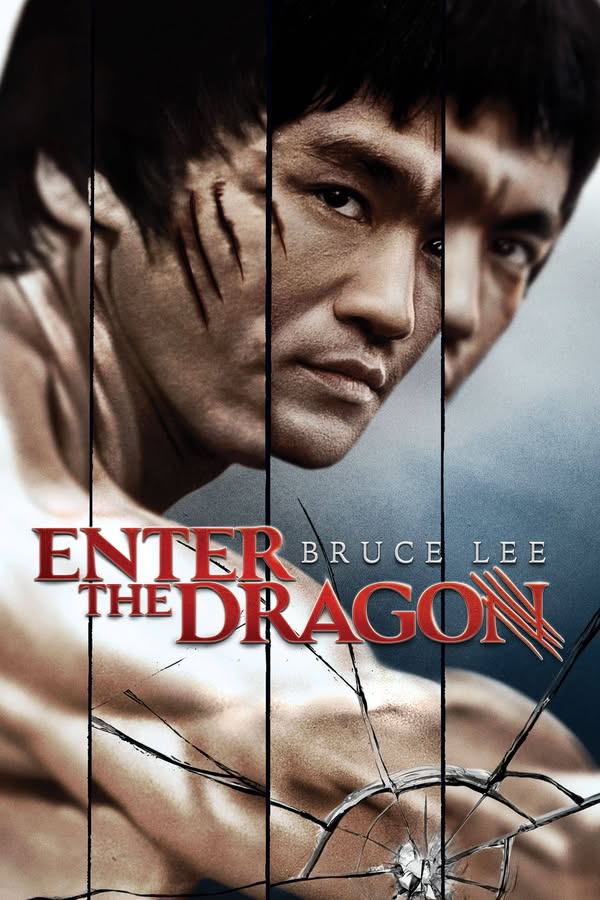
Tragically, Bruce Lee died on July 20, 1973, just weeks before the film’s U.S. premiere, at the age of 32. His sudden passing, attributed to cerebral edema, elevated Enter the Dragon to mythic status, as it became his final completed film and a posthumous showcase of his unparalleled talent. Released shortly after his death, the film capitalized on the ensuing media frenzy, cementing Lee’s legacy as a martial arts icon.
Plot and Setting
Enter the Dragon follows Lee, a Shaolin martial artist and master of Jeet Kune Do, recruited by British intelligence to infiltrate the island fortress of Han (Shih Kien), a reclusive crime lord and former Shaolin monk. Han is suspected of running a drug trafficking and prostitution ring, using a martial arts tournament as a front to recruit enforcers. Lee accepts the mission, driven by personal motives: Han’s henchman, Oharra (Robert Wall), was responsible for the death of Lee’s sister, Su Lin (Angela Mao). Joining Lee are two American fighters, Roper (John Saxon), a gambler with debts, and Williams (Jim Kelly), a Vietnam veteran and activist.
The film unfolds across two primary settings: the serene Shaolin Temple, where Lee’s philosophical training is highlighted, and Han’s opulent yet sinister island, a labyrinth of dungeons, mirrored chambers, and fighting arenas. The tournament serves as the narrative backbone, showcasing brutal matches while Lee investigates Han’s operations undercover. Key sequences include Lee’s nighttime reconnaissance, battles against Han’s guards, and the iconic hall-of-mirrors climax, where he confronts Han in a visually dazzling showdown.

The plot blends martial arts action with espionage thriller elements, drawing inspiration from Dr. No (1962) and The Man with the Golden Gun (1974). While the story is straightforward—undercover hero dismantles a criminal empire—it’s elevated by Lee’s charisma, philosophical musings (e.g., “Don’t think, feel”), and the cultural commentary woven into Williams’ and Roper’s arcs, touching on racial injustice and personal redemption. At 102 minutes, the film maintains a brisk pace, balancing intense fight scenes with moments of tension and humor.
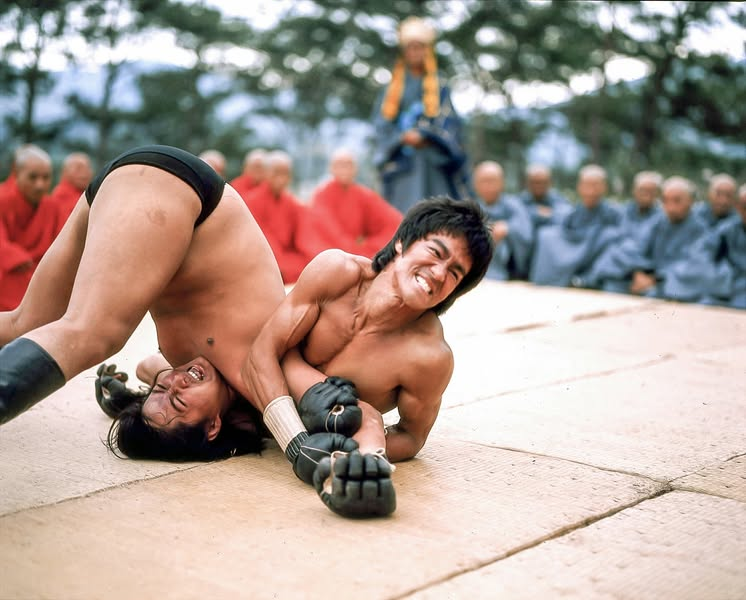
Cast and Characters
Enter the Dragon features a compact yet dynamic ensemble, with Bruce Lee as the undeniable centerpiece:
- Bruce Lee as Lee: Lee delivers a magnetic performance, blending physical prowess with quiet intensity. His portrayal of Lee, a disciplined martial artist with a personal vendetta, showcases his Jeet Kune Do techniques—fluid, efficient, and devastating. Lee’s screen presence, from his iconic nunchaku sequence to his philosophical exchanges, defines the film.
- John Saxon as Roper: Saxon, a veteran of action and horror films, plays Roper, a charming but indebted fighter. His roguish demeanor and competent martial arts skills (Saxon was a black belt in karate) add a Western perspective, making him a relatable co-lead for American audiences.
- Jim Kelly as Williams: Kelly, a real-life karate champion, brings charisma and defiance to Williams, a Black martial artist confronting systemic racism. His afro, swagger, and fight scenes, including a standout battle on the island, made him a breakout star, launching his blaxploitation career.
- Shih Kien as Han: The veteran Hong Kong actor portrays Han, a sophisticated yet ruthless villain with a metal hand, evoking Bond-esque antagonists. Shih’s commanding presence makes Han a worthy foe for Lee.
- Supporting Cast: Robert Wall as Oharra, Han’s brutal enforcer, delivers a memorable fight with Lee. Angela Mao as Su Lin appears briefly but leaves an impact in a flashback. Bolo Yeung as Bolo, Han’s muscular henchman, became a cult figure for his imposing physique and brief but intense clash with Roper.
The diverse cast reflects the film’s ambition to bridge cultural divides, with Lee’s Asian heritage, Saxon’s Western appeal, and Kelly’s African-American perspective creating a universal narrative. Notably, many actors performed their own stunts, enhancing the authenticity of the fight scenes.

Production and Creative Team
Enter the Dragon was a groundbreaking production for its time, blending Hollywood and Hong Kong filmmaking techniques:
- Director: Robert Clouse, though not a martial arts expert, excelled at framing Lee’s choreography, using wide shots and minimal cuts to showcase his speed and precision. Clouse’s experience with thrillers ensured a cohesive narrative, though Lee heavily influenced the fight sequences.
- Producers: Fred Weintraub, Paul Heller (Warner Bros.), and Raymond Chow (Golden Harvest) navigated the cross-cultural collaboration. Lee himself served as an uncredited co-producer, shaping the film’s vision.
- Screenwriter: Michael Allin crafted a script that balanced action with accessible storytelling, though Lee rewrote portions to emphasize his philosophy and cultural authenticity.
- Cinematography: Gilbert Hubbs captured the film’s contrasting aesthetics—serene temples versus Han’s fortress—using vibrant colors and dynamic angles. The hall-of-mirrors climax, inspired by The Lady from Shanghai (1947), remains a visual highlight.
- Music: Lalo Schifrin, known for Mission: Impossible and Dirty Harry, composed the iconic score, blending funky jazz, Asian instrumentation, and pulsating rhythms. The main theme, with its driving percussion, is instantly recognizable.
- Choreography: Bruce Lee designed the fight scenes, incorporating Jeet Kune Do, Wing Chun, and weapons like nunchaku and escrima sticks. His choreography emphasized realism and fluidity, contrasting with the staged theatrics of earlier kung fu films.
Filming in Hong Kong presented challenges, including language barriers and logistical issues, but the production’s low budget forced creative solutions, such as using real locations like the Tsing Shan Monastery. Lee’s perfectionism led to tensions with Clouse, but his insistence on authenticity elevated the film’s quality. Post-production was rushed to meet the August 1973 release, with some scenes, like the opening Shaolin sequence, added late to flesh out Lee’s backstory.

Critical Reception and Audience Response
Upon release, Enter the Dragon was a critical and commercial triumph. It grossed over $400 million worldwide (adjusted for inflation) against its $850,000 budget, becoming one of 1973’s highest-grossing films. Critics praised Lee’s charisma and the innovative action, though some dismissed the plot as formulaic. The New York Times called it “a furiously paced entertainment” with “dazzling fight sequences,” while Variety lauded Lee as “a star of phenomenal physical gifts.” Negative reviews, like Roger Ebert’s two-star rating, criticized the “clichéd” story but acknowledged Lee’s “awesome” presence.
Audiences embraced the film, with urban theaters in the U.S. reporting sold-out screenings, particularly among diverse communities drawn to Lee’s and Kelly’s representation. The film’s impact was amplified by Lee’s death, which sparked a global mourning that turned Enter the Dragon into a cultural phenomenon. Posts on modern platforms like Reddit and X highlight its enduring appeal, with users like @DragonFan69 (2025) calling it “the blueprint for every martial arts movie since.”
The film faced minor controversy for its violence, earning an R rating for gore (e.g., Han’s hand slicing a fighter) and implied sexual content. Some Hong Kong critics felt it pandered to Western tastes, but Lee’s global fanbase largely dismissed these concerns, celebrating his universal appeal.
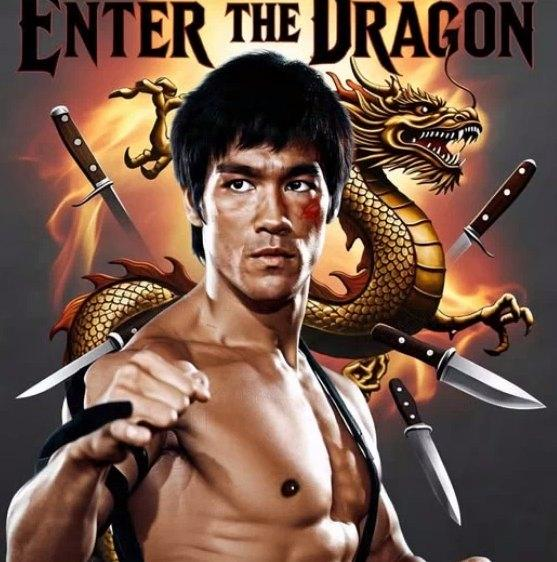
Significance and Legacy
Enter the Dragon revolutionized martial arts cinema, introducing the genre to mainstream Western audiences and inspiring countless films, from The Karate Kid (1984) to John Wick (2014). It broke racial barriers, showcasing an Asian lead in a Hollywood-backed production and paving the way for stars like Jackie Chan and Jet Li. The film’s influence extends beyond cinema, impacting video games (Mortal Kombat), hip-hop (Wu-Tang Clan’s Enter the Wu-Tang), and fitness culture, with nunchaku sales soaring post-release.
The film’s legacy is tied to Bruce Lee’s mythology. As his final completed work, it encapsulates his philosophy of self-expression and discipline, articulated in lines like “The art of fighting without fighting.” It also highlighted Hong Kong’s cinematic prowess, leading to a boom in kung fu imports. The Library of Congress selected Enter the Dragon for preservation in 2004, recognizing its cultural, historical, and aesthetic significance.
Subsequent releases, including a 1998 director’s cut with restored footage and a 2023 4K remaster, have kept the film relevant. Its iconic scenes—Lee’s nunchaku fight, the mirror room climax—remain benchmarks for action choreography. The film also launched Jim Kelly’s career and elevated Bolo Yeung to cult status, while its aesthetic influenced modern directors like Quentin Tarantino and the Wachowskis.
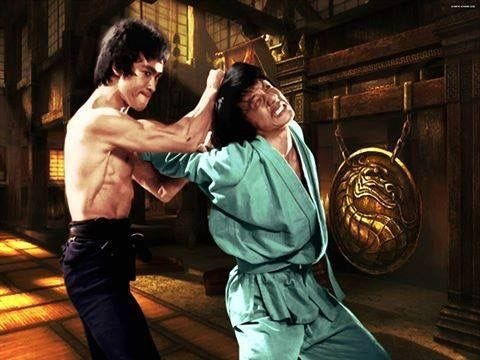
Conclusion
Enter the Dragon (1973) is more than a martial arts film; it’s a cultural milestone that redefined action cinema and immortalized Bruce Lee as a global icon. With its thrilling fight choreography, philosophical depth, and diverse cast, the film transcends its genre roots, blending Hong Kong artistry with Hollywood ambition. Directed by Robert Clouse and elevated by Lee’s genius, it remains a timeless showcase of physical and emotional storytelling. Over five decades later, Enter the Dragon continues to inspire filmmakers, martial artists, and audiences, its legacy as potent as Lee’s lightning-fast kicks. For those seeking the pinnacle of martial arts cinema, this film is, and always will be, the dragon’s lair.